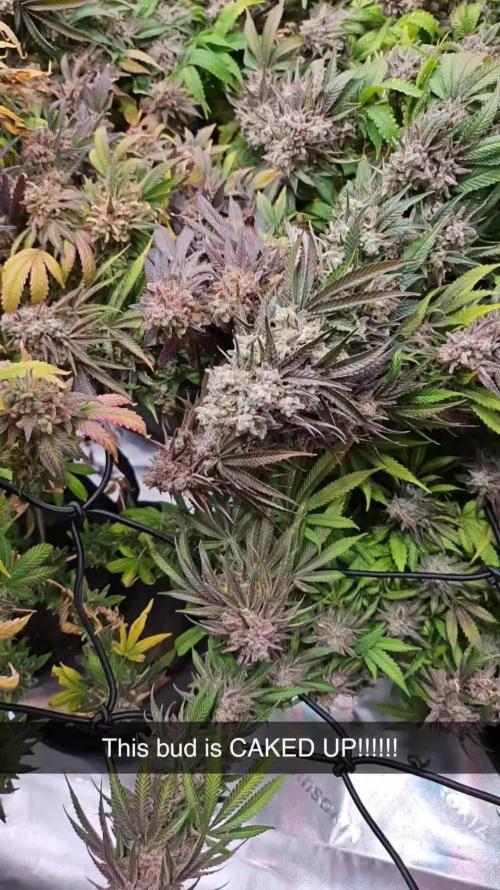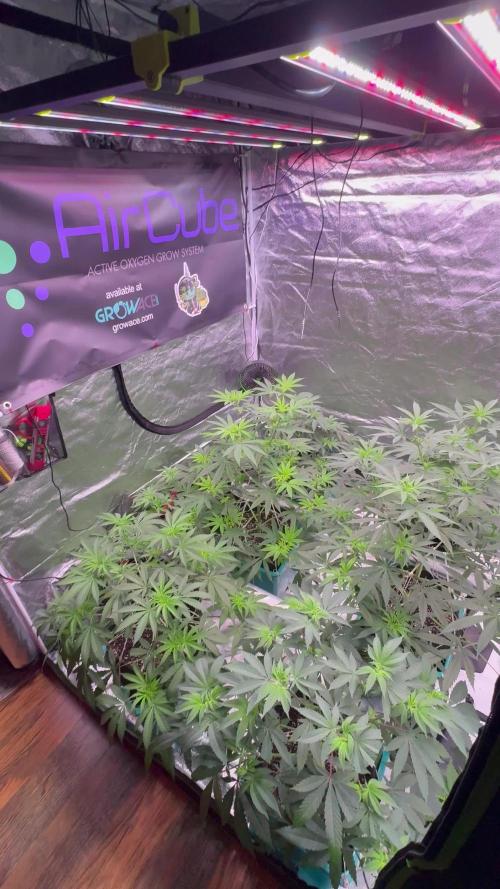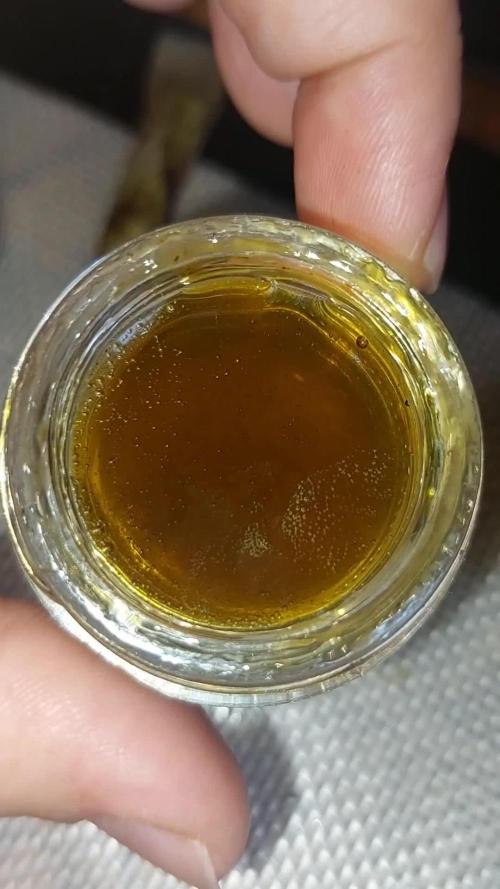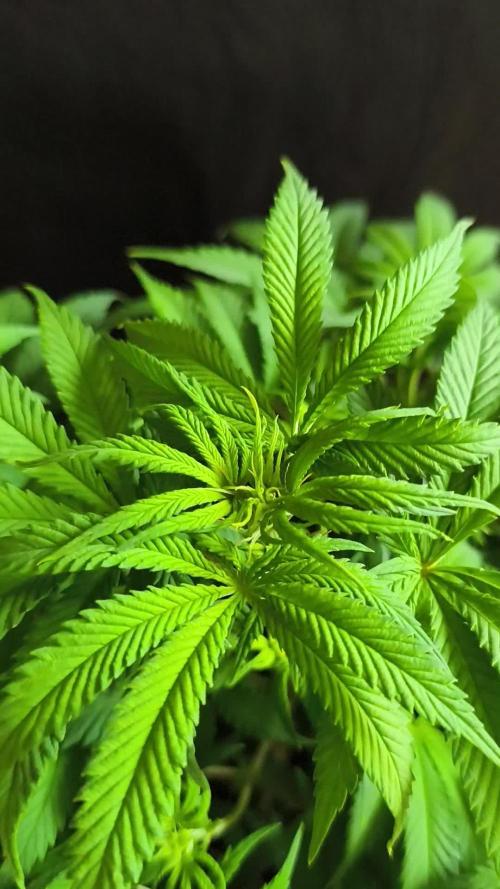The Grow Awards 2026 🏆 

































Likes
Comments
Share


@Ultraviolet
Follow
You don't become confident by shouting affirmations in the mirror, but by having a stack of undeniable proof that you are who you say you are, outwork your self-doubt.
Nitrogen fixation is a chemical process by which molecular nitrogen (N2), which has a strong triple covalent bond, is converted into ammonia (NH3) or related nitrogenous compounds, typically in soil or aquatic systems but also in industry. The nitrogen in air is molecular dinitrogen, a relatively nonreactive molecule that is metabolically useless to all but a few microorganisms. Biological nitrogen fixation or diazotrophy is an important microbe-mediated process that converts dinitrogen (N2) gas to ammonia (NH3) using the nitrogenase protein complex (Nif).[2][3]
Nitrogen fixation is essential to life because fixed inorganic nitrogen compounds are required for the biosynthesis of all nitrogen-containing organic compounds, such as amino acids and proteins, nucleoside triphosphates and nucleic acids. As part of the nitrogen cycle, it is essential for agriculture and the manufacture of fertilizer. It is also, indirectly, relevant to the manufacture of all nitrogen chemical compounds, which include some explosives, pharmaceuticals, and dyes.
Nitrogen fixation is carried out naturally in soil by microorganisms termed diazotrophs that include bacteria, such as Azotobacter, and archaea. Some nitrogen-fixing bacteria have symbiotic relationships with plant groups, especially legumes.[4] Looser non-symbiotic relationships between diazotrophs and plants are often referred to as associative, as seen in nitrogen fixation on rice roots. Nitrogen fixation occurs between some termites and fungi.[5] It occurs naturally in the air by means of NOx production by lightning.[6][7]
All biological reactions involving the process of nitrogen fixation are catalyzed by enzymes called nitrogenases.[8] These enzymes contain iron, often with a second metal, usually molybdenum but sometimes vanadium.
Green clover (Fixation)
White clover (Fixation)
Red Clover. (Fixation)
Yellow Clover. (Fixation, deeper roots)
Sweet Thai Basil. (Terpenes)
Italian Basil. (Terpenes)
Chamomile.(Oil production)
Borage.(Pest attraction taste)
Lavender.(Pest attraction smell)
Marigold(Pest attraction visual)
Mycorrhizae are beneficial associations between mycorrhizal fungi and a plant’s root system. Mycorrhizal fungi spores germinate in the soil, creating filaments (hyphae) that penetrate the root cells, thus establishing a symbiotic relationship. This collaboration leads to the development of both intra-radical and extra-radical networks of filaments, enabling efficient exploration of the soil for enhanced access to nutrients and water. Consequently, these vital resources are transferred to the plant, resulting in numerous benefits for crop cultivation.
Various mycorrhizal products are available in diverse formulations (powder, granular, and liquid), concentrations, and qualities. Ongoing advancements in products, technologies, and research are reshaping our understanding of mycorrhizae. Despite these positive developments, certain misconceptions persist. In the following discussion, we aim to clarify the truths and dispel the myths surrounding mycorrhizae products.
MYTH #1
A HIGHER NUMBER OF MYCORRHIZAE SPECIES MEANS BETTER RESULTS.
Contrary to common belief, having a higher number of mycorrhizae species in a product does not translate to better results; in fact, it often yields the opposite outcome. A plant can sustain only one association with a particular mycorrhizal fungi species. Introducing multiple species creates competition among them, which is not advantageous for the plant. The initial colonizer does not ensure the highest success; instead, it gains precedence. It is recommended to select a product with a concentrated presence of a single mycorrhizae species known for its effective performance, rather than opting for a product with multiple species at lower concentrations.
MYTH #2
ECTOMYCORRHIZAE ARE EFFECTIVE FOR CANNABIS PLANTS.
Although ectomycorrhizae can colonize five to ten percent of plant species, cannabis is not among them. Ectomycorrhizae do not penetrate the root cells; instead, they develop around the roots and on the exterior. For cannabis plants, it is essential to seek out endomycorrhizae. Endomycorrhizae are capable of colonizing 70% to 90% of plant species, including cannabis. Unlike ectomycorrhizae, endomycorrhizae penetrate the root cells, forming structures like arbuscules for the exchange of nutrients and water with the plant.
MYTH #3
WHOLE INOCULANT (PROPAGULES) PERFORM BETTER THAN ONLY VIABLE SPORES.
The propagule count specified on most mycorrhizae products indicates the presence of spores (viable and unviable), hyphae, and root fragments. However, it is crucial to note that only viable spores, those with the capacity to germinate, can successfully colonize a plant’s root system. Spores are to mycorrhizal fungi what seeds are to cannabis plants—a fundamental component enabling fungi reproduction. Consequently, even if a mycorrhizal product boasts millions of propagules, its effectiveness hinges on the presence of viable spores. Without viable spores, the product will not contribute to plant development. Therefore, the genuine value of a mycorrhizal inoculant lies in the quantity of viable spores it contains, as only viable spores can efficiently initiate symbiosis.
MYTH #4
ALL METHODS OF APPLICATION YIELD IDENTICAL RESULTS.
To establish the symbiosis, mycorrhizal fungi spores must be close to the plant roots. The optimal recommendation is to directly apply mycorrhizal inoculant to the roots, either in powder, granular or slurry form. This method ensures maximum proximity between the spores and the roots, facilitating a rapid establishment of symbiosis. Particularly with crops like cannabis, which have a short growing cycle, employing this technique is the most effective way to obtain optimal benefits. Alternatively, techniques such as blending the inoculant with the soil are effective, but there may be a delay in the establishment of symbiosis. This is because the roots need to grow and come into contact with the dispersed spores throughout the growing media.
MYTH #5
MYCORRHIZAE CAN ONLY BE GROWN ON LIVING PLANTS.
While the predominant method for commercially producing mycorrhizae involves growing them on the root systems of living plants (in vivo production), it is not the exclusive nor the optimal technique. In fact, this production approach has notable drawbacks that the “root organ culture” method just does not have (in vitro production). In vitro production occurs in meticulously controlled, aseptic laboratory conditions, allowing for the consistent generation of products that are viable, highly concentrated, species-specific, and free from pathogens. Achieving such precision and quality is impossible when relying on the cultivation of mycorrhizal fungi on plants exposed to external conditions.
In conclusion, it is crucial to take all these factors into consideration when choosing the appropriate product for your crop to fully harness the wide array of benefits provided by a high-quality mycorrhizal product.
STRONGER PLANT – Stress resistance.
FASTER GROWTH – Improve plant structure and shorter veg time.
INCREASE YIELD – Overall more biomass.
IMPROVED QUALITY – Increase cannabinoids and terpenes content.
Likes
44
Share


@ILoVeThiSpLaNt
Follow
Giorni 28
Che spettacolo di odori!!!
Le Rainbow sono lime/zkittlez/uva e ti impregnano le mani e ti viene voglia di staccarle e fumarle ora.
Le due Pink sanno di gas/pesca (una mi ricorda l'erba più buona che ho mai fumato e cioè l' Oz Kush). Anche se una ha avuto problemi e l'ho dovuta sciacquare (#2) ora sembra stare meglio anche se alzando i fertilizzanti il colore è ancora un po' giallo.
Le tre Barbara'Pie posso solo dire anche qui frutta allo stato puro ma con qualcosa ancora che non riesco a capire. Due sono molto simili l'altra è più cicciotta.
La Baker Delight piena di resina e odora leggermente di biscotti ma è la pianta più indietro di tutte.
Ci vediamo settimana prossima e ricorda di spendere il tuo tempo nella ricerca del seme e che nessuno ti regala niente di buono 😏
Likes
26
Share


@Highgrade_Harvests
Follow
One more week of veg then flipping the lights to 12/12. I've been so busy with work and the outside garden that I haven't had much time to maintain these plants but they are doing very well considering. I've topped all plants and pulled branches down to spread canopy. A lot of defoliation has been needed along the way and I've done some lst and hst also. Once I flip the lights they should fill the tent up nicely. Being conservative with the nutrients. I will bump up a little bit once they are in flower.
Likes
34
Share


@420DeepGrow
Follow
Día 22: 🔹Riego según la tabla de nutrientes BioBizz con una EC de 900 y un pH de 6.2.
🔹Pulverización con Rootbastic a 0.15ml/l.
✳️Nota: creo que finalmente el Sabado las pasaré a floración, 12/12.Leevarán ahora entre 3/4 semanas con unos 5 días de diferencia ( hay cañamones que puse más tarde.
Día 23: 🔹Pulverización con Rootbastic a 0,1ml/l
🔹Tengo que volver a regar, aplique poca agua ( 250ml x maceta) y le aplico 370ml x maceta ya que no dispongo de más agua sin cloro. La próxima vez las regare con 1/2 litro a cada una . Riego según lo tabla Biobizz con una EC baja 900-1000ppm
Likes
98
Share


@Cauli
Follow
Runtz was choped and wet trimmed on day 120, 74 days after switching to 12/12.
Was an quite easy trim job, few leafs and a lot of big and very dense nuggets.
Super sticky with a beautiful smell.
Just love her!
Thank you @Zamnesia and @Plagron for hosting this contest!
It really was a blast and had so much fun with the community. So many wonderful plants and great pictures – will always remember this as a great time with a good spirit 💚💚💚
I am very grateful to have won the Eternity grow cup 2025 with this diary.
Would love to show off the prices, but can't add any pictures to this week – so you will find them in the last week :)
Likes
13
Share


@Srp710
Follow
2 weeks have passed since last update. A lot has happened, plant in front/back falling over on itself since it was LST'ed too far from main branch, have been trying to use the trellis net and tie some of them up. Runtz muffin on the right looks ready to harvest, the mandarin cookies look like they will both need another week or two. Trichomes milky on the runtz muffin, 10-20% amber and pistils all coiled towards the plant, beautiful orange color and the buds are caked with trichomes. Gearing up to be an amazing first grow in the books!!! Wish I had refrained on last dose of fert, wasnt expecting to harvest these quite this fast. Mandarin cookies definitely seeing some nutrient problems, assuming thats just because of how late we are into flower.
Likes
101
Share


@Ferenc
Follow
Day 58, 11th of November 2020:
I set the lamp 15 minutes shorter to switch off earlier so they receive 11:45 of darkness. I would like to imitate the nature when longer nights come with time till the 4th week (when they will receive 13 hours darkness a day 15 minutes minus 4 times = 1hour) so every week 15 min longer darkness for 4 weeks and then back to 12/12 to have bigger buds from the 4th week....
Wao. Well, all good hopefully they will stop growing soon but the strech is not that much thanks for the trainings such as topping and LST....
Pistils are started appearing so they she the sex I think one more week to go and they will settle down concentrating on bud development.
What to say every 2nd day is fertilization with the mix and ratio above now we are waiting.
Anything else? Well just look atbthe pictures and decide what you think. I am pretty sure they look cool LOL.
This Gleato Zamnesia is very promising I really like the smell already she is nice but all of them I mean I am in love with all so. Kalinia Asia is nice and I am so excited for the Sweed Seeds ones the red girls OMG :)
Likes
29
Share


@CannbellFarms
Follow
Was such a pleasant harvest from start to finish, no issues at all. A tip for next time would be to have the SCRoG lower as I couldn’t really tuck any node sights this time round, smells absofuckinglutely amazing from 3RD week bloom onwards!
Likes
73
Share


@Ferenc
Follow
Day 96, 15th of December 2020:
Hi! A bit late I was on holiday I usually start the week with the first day but now with the last one.
I just put a stick there was not necessarily but looks better with it...
She is a haevy yielder girl.... the buds are thick so thick I am amazed....
This genetics is amazing as well....
All the structure is pretty much cool she is outstanding quality lady....
Solid... just grows nicely a bit strechy but nothing serious....
Almost done by Christmas she is.
By the way I am going on holiday again and back on 28th of December so after harvest starts.
She needs more time from now but it would not be an issue to be cut if needed.
The 7th weeks starts with tomorrow 16th of December....
Only flushing and no more nutritient will be used.
Soon full report comes. Lamp is the same 11 hours on and 13 off....
The last 4 days she will get 4 days darkness and only ventilation will be working no even more water ;)
Likes
13
Share


@GrowGuy97
Follow
Day 49 - Had to put the 3 Girl Scout cookies on a 12/12 light cycle to get them to switch to flower for some reason, first time I have had that happen with autos but all the plants are doing good, 2 of my strawberry pies are showing a little calmag deficiency but overall they are doing great and getting extremely frosty! Thanks for following & happy growing friends!✌️🏼🙏🏼🌱
Processing
Likes
17
Share


@greennug
Follow
grow room adjustments this week. plants are now more spread out under a total of 5 600w HPS lights. 3 fastbuds plants have an additional 45w LED light. by week 3/4 they will occupy my whole grow space and an additional 3 600w HPS lights will be added.
Plants are looking healthy and 10 or so have been topped for the first time on day 8. dinafem cookies are looking very good in structure. will upload pics every day until harvest! thanks for looking. UPDATE day 12 veg, they are looking beautiful better than i expected. there are 36 in 15litre pots now and i cant wait to make my final grow room upgrage next week and for my room to be looking like a forest! im hoping for 2-3kg off these girls and only time will tell. i will keep doing daily updates until harvest
Likes
119
Share


@Roberts
Follow
Divine indica is growing great. Plant is happy and leaves are praying. Everything is looking super good and going good. I been keeping up on lst and defoliation when needed. I will likely change her to 12/12 next update to start the flowering process. I am limited on space in the tent, and I don't want her getting too big. She is looking super good. Thank you Spider Farmer, and Divine Seeds. 🤜🏻🤛🏻🌱🌱🌱
Thank you grow diaries community for the 👇likes👇, follows, comments, and subscriptions on my YouTube channel👇. ❄️🌱🍻
Happy Growing 🌱🌱🌱
https://youtube.com/channel/UCAhN7yRzWLpcaRHhMIQ7X4g
Likes
7
Share


@Naujas
Follow
well, it's exactly 12 weeks :) and my house is full of lemon aroma :) the girl endured really difficult growth, but she coped with everything perfectly :) who followed the growth, you saw that she grew on the balcony for 10 weeks, and she spent the last 2 in the grow tent :) 500 gr wet weight !!!!:) , before putting it in the ground I expected less than 10 g dry yield :D then this growth turned out super well, if it wasn't for my vacation I would have let it grow for about 2 weeks I think. but everything is still very good, I'll go home, fix it and do a smoke review :).
Likes
4
Share


@805homegrown
Follow
Apple fritter and wilson! Zero are 7 weeks from popping the seed's in ro water ph to 6.2 and mystery mix, Geist grow are 4 weeks from popping the seed's same process as above.
Blumat watering system
3x3 area for growing 4 plants in 4 10gallon fabric pots in living soil top feed with compost tea and foliage spray (LABS) lactic acid bacteria. 2 x TS1000 and I use pod tech to feed my worms with down to earth amendments.
Likes
5
Share


@Ninjabuds
Follow
The biggest plant in the tent by far. Definitely gonna have to watch out for this one getting too tall too fast
Likes
Comments
Share


@deseed_uy
Follow
Una delicia esta genetica, muy alimonada.
Lo que he notado del 13/11 ademas de que se atrasa bastante la cosecha, es la cantidad de tricomas q se generan, y las flores quedan hecha roca. Excelente servicio para el q sabe eaperar
Likes
36
Share


@GYOweed
Follow
One pheno smells like straight up slurricane i grew from clones so im sure not a mixed up seed lol
One pheno has not much scent and probably leans bubba kush.
I have no idea where this sweet candy berry pheno is coming from...probably wedding cake.
I hope to get some damn cheese from the 3rd one that i saved but didnt make the flower room cut.
Size and trichomes for week 3 is satisfactory given i did a heavy defoliaton at flip, and these are only 10L/3 gallon grow bags sharing a 200w light.
Tried to stop stretch with cytokinins and kelp but i may have to raise the lights?































